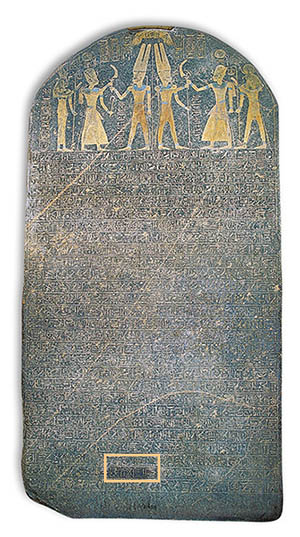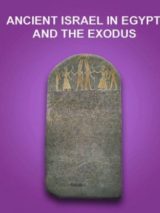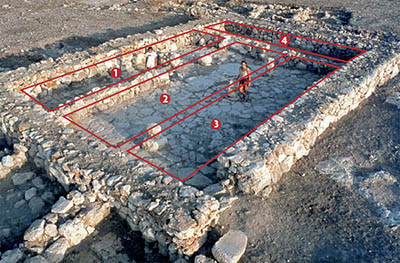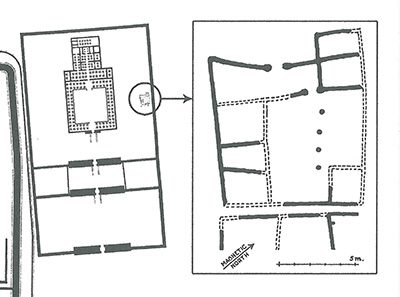Evidence of Israel’s Exodus from Egypt


Dated to c. 1219 B.C.E., the Merneptah Stele is the earliest extrabiblical record of a people group called Israel. Set up by Pharaoh Merneptah to commemorate his military victories, the stele proclaims, “Ashkelon is carried off, and Gezer is captured. Yeno’am is made into nonexistence; Israel is wasted, its seed is not.” Ashkelon, Gezer and Yeno’am are followed by an Egyptian hieroglyph that designates a town. Israel is followed by a hieroglyph that means a people. Photo: Maryl Levine.
Is the Biblical Exodus fact or fiction?
This is a loaded question. Although Biblical scholars and archaeologists argue about various aspects of Israel’s Exodus from Egypt, many of them agree that the Exodus occurred in some form or another.
The question “Did the Exodus happen” then becomes “When did the Exodus happen?” This is another heated question. Although there is much debate, most people settle into two camps: They argue for either a 15th-century B.C.E. or 13th-century B.C.E. date for Israel’s Exodus from Egypt.
The article “Exodus Evidence: An Egyptologist Looks at Biblical History” from the May/June 2016 issue of Biblical Archaeology Review1 wrestles with both of these questions—“Did the Exodus happen?” and “When did the Exodus happen?” In the article, evidence is presented that generally supports a 13th-century B.C.E. Exodus during the Ramesside Period, when Egypt’s 19th Dynasty ruled.
The article examines Egyptian texts, artifacts and archaeological sites, which demonstrate that the Bible recounts accurate memories from the 13th century B.C.E. For instance, the names of three places that appear in the Biblical account of Israel’s Exodus from Egypt correspond to Egyptian place names from the Ramesside Period (13th–11th centuries B.C.E.). The Bible recounts that, as slaves, the Israelites were forced to build the store-cities of Pithom and Ramses. After the ten plagues, the Israelites left Egypt and famously crossed the Yam Suph (translated Red Sea or Reed Sea), whose waters were miraculously parted for them. The Biblical names Pithom, Ramses and Yam Suph (Red Sea or Reed Sea) correspond to the Egyptian place names Pi-Ramesse, Pi-Atum and (Pa-)Tjuf. These three place names appear together in Egyptian texts only from the Ramesside Period. The name Pi-Ramesse went out of use by the beginning of Egypt’s Third Intermediate Period, which began around 1085 B.C.E., and does not reappear until much later.


These specific place names recorded in the Biblical text demonstrate that the memory of the Biblical authors for these traditions predates Egypt’s Third Intermediate Period. This supports a 13th-century Exodus during the Ramesside Period because it is only during the Ramesside Period that the place names Pi-Ramesse, Pi-Atum and (Pa-)Tjuf (Red Sea or Reed Sea) are all in use.
A worker’s house from western Thebes also seems to support a 13th-century Exodus. In the 1930s, archaeologists at the University of Chicago were excavating the mortuary Temple of Aya and Horemheb, the last two pharaohs of Egypt’s 18th Dynasty, in western Thebes. The temple was first built by Aya in the 14th-century B.C.E., but Horemheb usurped and expanded the temple when he became pharaoh. (He ruled from the late 14th century through the early 13th century B.C.E.) Horemheb chiseled out every place where Aya’s name had been and replaced it with his own. Later—during the reign of Ramses IV (12th century B.C.E.)—the Temple of Aya and Horemheb was demolished.
During their excavations, the University of Chicago uncovered a house and part of another house belonging to the workers who were given the task of demolishing the temple. The plan of the complete house is the same as that of the four-room house characteristic of Israelite dwellings during the Iron Age. However, unlike the Israelite models that were usually constructed of stone, the Theban house was made of wattle and daub. It is significant that this house was built in Egypt at the same time that Israelites were constructing four-room houses in Canaan. The similarities between the two have caused some to speculate that the builders of the Theban house were either proto-Israelites or a group closely related to the Israelites.


Is this a proto-Israelite house? This plan shows the 12th-century B.C.E. worker’s house in western Thebes next to the Temple of Aya and Horemheb. The house is undoubtedly a four-room house. In Canaan, the four-room house is considered an ethnic marker for the presence of Israelites during the Iron Age. Is the Biblical Exodus fact or fiction? This favors “fact,” so the question becomes, “When did the Exodus happen?” The presence of such a house in Egypt during the 12th century B.C.E. seems to support an Exodus during the Ramesside Period. Photo: Courtesy of Manfred Bietak.
A third piece of evidence for the Exodus is the Onomasticon Amenope. The Onomasticon Amenope is a list of categorized words from Egypt’s Third Intermediate Period. Written in hieratic, the papyrus includes the Semitic place name b-r-k.t, which refers to the Lakes of Pithom. Even in Egyptian sources, the Semitic name for the Lakes of Pithom was used instead of the original Egyptian name. It is likely that a Semitic-speaking population lived in the region long enough that their name eventually supplanted the original.
Watch full-length lectures from the Out of Egypt: Israel’s Exodus Between Text and Memory, History and Imagination conference, which addressed some of the most challenging issues in Exodus scholarship. The international conference was hosted by Calit2’s Qualcomm Institute at UC San Diego in San Diego, CA.
Another compelling piece of evidence for the Exodus is found in the Biblical text itself. A history of enslavement is likely to be true. The article explains:
The storyline of the Exodus, of a people fleeing from a humiliating slavery, suggests elements that are historically credible. Normally, it is only tales of glory and victory that are preserved in narratives from one generation to the next. A history of being slaves is likely to bear elements of truth.


Exodus: Fact or fiction? This four-room house from Izbet Sartah, Israel, shares many similarities with the 12th-century B.C.E. worker’s house uncovered in western Thebes. Photo: Israel Finkelstein/Tel Aviv University.
So, is the Biblical Exodus fact or fiction? Scholars and people of many faiths line up on either side of the equation, and some say both. Archaeological discoveries have verified that parts of the Biblical Exodus are historically accurate, but archaeology can’t tell us everything. Although archaeology can illuminate aspects of the past and bring parts of history to life, it has its limits.
It certainly is exciting when the archaeological record matches with the Biblical account—as with the examples described here. However, while this evidence certainly adds weight to the historical accuracy of elements of the Biblical account, it can’t be used to “prove” that every detail of the Exodus story in the Bible is true.
To learn more about evidence for Israel’s Exodus from Egypt, read the full article “Exodus Evidence: An Egyptologist Looks at Biblical History” in the May/June 2016 issue of Biblical Archaeology Review.
——————Subscribers: Read the full article “Exodus Evidence: An Egyptologist Looks at Biblical History” in the May/June 2016 issue of Biblical Archaeology Review.
Not a subscriber yet? Join today.
This Bible History Daily feature was originally published on April 10, 2016.
Notes:
1. This BAR article is a free abstract from Manfred Bietak’s article “On the Historicity of the Exodus: What Egyptology Today Can Contribute to Assessing the Biblical Account of the Sojourn in Egypt” in Thomas E. Levy, Thomas Schneider and William H.C. Propp, eds., Israel’s Exodus in Transdisciplinary Perspective: Text, Archaeology, Culture and Geoscience (Cham: Springer, 2015). In Bietak’s article, the scholarly debate about the archaeological remains and the onomastic data of Wadi Tumilat is more elaborately treated.


Related reading in Bible History Daily:
Exodus in the Bible and the Egyptian Plagues
Who Was Moses? Was He More than an Exodus Hero?
Out of Egypt: Israel’s Exodus Between Text and Memory, History and Imagination
Excruciating Exodus Movie Exudes Errors
Does the Merneptah Stele Contain the First Mention of Israel?
Become a Member of Biblical Archaeology Society Now and Get More Than Half Off the Regular Price of the All-Access Pass!
Explore the world’s most intriguing Biblical scholarship
Dig into more than 9,000 articles in the Biblical Archaeology Society’s vast library plus much more with an All-Access pass.


